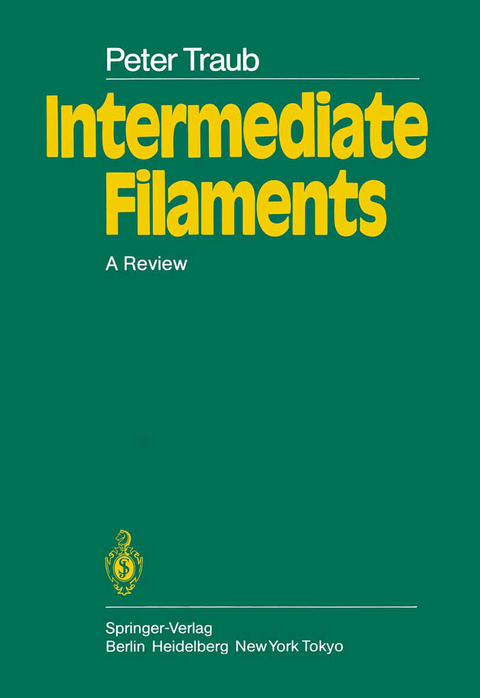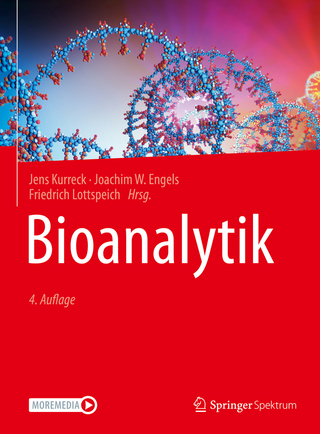
Intermediate Filaments
Springer Berlin (Verlag)
978-3-642-70232-7 (ISBN)
1 Introduction.- 2 Distribution of Intermediate Filaments.- 2.1 Intercellular Distribution of Intermediate Filaments.- 2.1.1 Intermediate Filaments in Early Differentiation.- 2.1.1.1 Murine Embryogenesis.- 2.1.1.2 Chick Embryogenesis.- 2.1.1.3 Teratocarcinoma Cells.- 2.1.1.4 Epithelial Cell Differentiation.- 2.1.1.5 Myogenesis.- 2.1.2 Intermediate Filament Proteins in Differentiated Tissues.- 2.1.2.1 Cytokeratins.- 2.1.2.2 Desmin.- 2.1.2.3 Vimentin.- 2.1.2.4 Glial Fibrillary Acidic Protein (GFAP).- 2.1.2.5 Neurofilament Proteins.- 2.1.3 Intermediate Filaments in Disease.- 2.1.3.1 Tumor Diagnosis.- 2.1.3.2 Mallory Bodies.- 2.1.3.3 Neuropathies.- 2.1.3.4 Autoantibodies.- 2.1.4 Intermediate Filament Proteins in Evolution.- 2.1.5 Potential Intermediate Filament Subunit Proteins.- 2.1.5.1 Synemin.- 2.1.5.2 Paranemin.- 2.1.5.3 66 kDa Protein.- 2.1.5.4 68 kDa Protein.- 2.1.5.5 95 kDa Protein.- 2.1.5.6 50 kDa Neurofilament Proteins.- 2.1.5.7 60 to 70 kDa Intermediate Filament-Associated Proteins.- 2.1.6 Intermediate Filament Proteins in Cell Culture.- 2.1.6.1 Vimentin.- 2.1.6.2 Desmin.- 2.1.6.3 Glial Fibrillary Acidic Protein.- 2.1.6.4 Neurofilament Proteins.- 2.1.6.5 Cytokeratins.- 2.2 Intracellular Distribution of Intermediate Filaments and Their Interaction with Organelles and Proteins.- 2.2.1 Microtubules.- 2.2.2 Microfilaments.- 2.2.3 Mitochondria.- 2.2.4 Plasma Membrane.- 2.2.5 Nucleus.- 2.2.6 Endoplasmic Reticulum and Golgi Apparatus.- 2.2.7 Other Cellular Organelles.- 2.2.8 Proteins and Enzymatic Activities.- 2.2.8.1 Filaggrin.- 2.2.8.2 Microtubule-Associated Proteins (MAPs).- 2.2.8.3 Enzymes and Other Proteins.- 2.2.9 Intermediate Filaments in Muscle.- 2.3 Intracellular Reorganization of Intermediate Filament Systems.- 2.3.1 Mitosis.- 2.3.2 Microinjection of Antibodies.- 2.3.3 Virus Infection.- 2.3.4 Receptor-Mediated Endocytosis.- 2.3.5 Drugs, Toxins, and Growth Factors.- 2.3.6 Physical Manipulations.- 2.3.7 Cell Spreading.- 2.4 In Vivo Assembly of Intermediate Filaments.- 2.5 Isolation and Subunit Composition of Intermediate Filaments.- 3 In Vitro Assembly and Structure of Intermediate Filaments.- 3.1 In Vitro Reconstitution.- 3.1.1 Cytokeratin Filaments.- 3.1.2 Vimentin and Desmin Filaments.- 3.1.3 Glial Filaments.- 3.1.4 Neurofilaments.- 3.2 Helical Substructure.- 3.3 Architecture of Protofilaments.- 3.3.1 Three-Strand Model of Protofilaments.- 3.3.2 Four-Strand Model of Protofilaments.- 3.4 Function of the N-Terminal Polypeptide.- 3.5 Structure of Intermediate Filament Subunit Proteins.- 3.5.1 Peptide Mapping.- 3.5.2 Amino Acid Composition.- 3.5.3 Amino Acid Sequence.- 3.5.3.1 Desmin.- 3.5.3.2 Vimentin.- 3.5.3.3 Glial Fibrillary Acidic Protein.- 3.5.3.4 Neurofilament Proteins.- 3.5.3.5 Cytokeratins.- 3.5.3.6 Wool ?-Keratins.- 3.5.3.7 General Remarks on the Structure of Intermediate Filament Proteins.- 4 Synthesis of Intermediate Filament Proteins in Vitro.- 5 Posttranslational Modification of Intermediate Filament Proteins.- 5.1 Phosphorylation of Intermediate Filament Proteins.- 5.1.1 Neurofilament Proteins.- 5.1.2 Desmin and Vimentin.- 5.1.3 Cytokeratins.- 5.1.4 Phosphorylation Sites.- 5.1.5 Functional Role of Intermediate Filament Protein Phosphorylation.- 5.2 Ca2+-Dependent Proteolysis of Intermediate Filament Proteins.- 5.2.1 Neurofilament Proteins.- 5.2.2 Glial Fibrillary Acidic Protein.- 5.2.3 Vimentin and Desmin.- 5.2.4 Cytokeratins.- 5.2.5 Relatedness of Different Ca2+-Activated Proteinases.- 5.2.6 Putative Site of Action of Ca2+-Activated Proteinases.- 5.3 Modification of Intermediate Filament Proteins by Transglutaminases.- 5.3.1 Neurofibrillary Tangles.- 5.3.2 Transglutaminases in Nonneural Cells.- 5.3.3 Properties and Putative Site of Action of Transglutaminases.- 5.3.4 Are Transglutaminases and Ca2+-Activated Proteinases Jointly Involved in Receptor-Mediated Endocytosis?.- 6 Cellular Function(s) of Intermediate Filaments and Their Subunit Proteins.- 6.1 Interaction in Vitro of Intermediate Filament Prot
| Erscheint lt. Verlag | 17.11.2011 |
|---|---|
| Zusatzinfo | X, 266 p. |
| Verlagsort | Berlin |
| Sprache | englisch |
| Maße | 170 x 244 mm |
| Gewicht | 487 g |
| Themenwelt | Naturwissenschaften ► Biologie ► Mikrobiologie / Immunologie |
| Naturwissenschaften ► Biologie ► Zellbiologie | |
| Schlagworte | Cell • Development • Microscopy • Protein • proteins • Regulation • synthesis • tissue • Zelle |
| ISBN-10 | 3-642-70232-5 / 3642702325 |
| ISBN-13 | 978-3-642-70232-7 / 9783642702327 |
| Zustand | Neuware |
| Haben Sie eine Frage zum Produkt? |
aus dem Bereich


